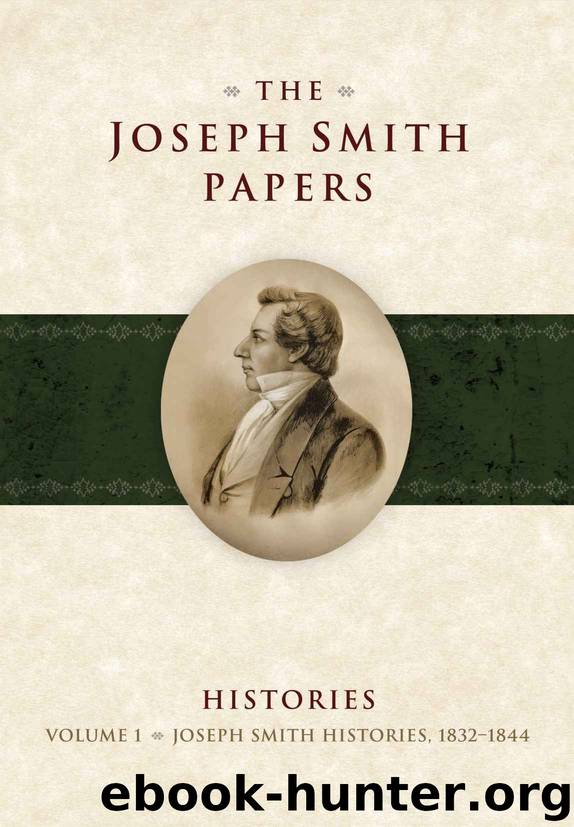The Joseph Smith Papers: Histories, Volume 1: Joseph Smith Histories, 1832-1844 by Karen Lynn Davidson

Author:Karen Lynn Davidson [Davidson, Karen Lynn]
Language: eng
Format: epub
Tags: Gospel Teachings
Publisher: Church Historian's Press
Published: 2012-01-01T07:00:00+00:00
History, circa 1841 [Draft 3]
Source Note
JS, History, [ca. 1841], draft; handwriting of Howard Coray; 102 pages and one attached slip; CHL.
Howard Coray inscribed two copies of a new draft of JS’s history in about 1841. The earlier draft copy is the document transcribed herein. At the bottom of page 1 of the later fair copy is an inscription in the handwriting of Howard Coray identifying it as the second copy, and similar inscriptions are found on the last page of each bifolium of the fair copy. In addition to the draft copy and the fair copy, there is a four-page partial copy, also in the handwriting of Howard Coray, that corresponds to text on pages 13–16 of both the draft and fair copies.1
The draft copy contains twenty-five bifolia (making one hundred pages) and a final loose leaf. Pages 1–92 measure from 12½ to 12⅝ inches high and 7⅝ inches across (32 × 19 cm); pages 93–102 measure 12 × 7⅝ inches (30 × 19 cm). The larger pages are lined with between thirty-four and thirty-eight blue horizontal lines, and the shorter pages contain thirty-eight blue horizontal lines; most of the ruling throughout the manuscript is now faint or completely faded. Page numbering appears at the top center of each page. Embossed in the upper left corner of the first recto side of many bifolia is a decorative star and “D & J. Ames Springfield”, the insignia of a Springfield, Massachusetts, paper mill firm established by brothers David and John Ames in 1828.2
The draft was inscribed in ink that is now brown. It includes several graphite insertions in Coray’s handwriting. Quill and steel pens were used interchangeably for inscription. The paper is cream colored and yellowed at the edges, with some foxing. The first page and last page of the draft exhibit moderate wear. Ink was spilled on the gutter edge of the stacked manuscript, slightly staining many bifolia. At one time the manuscript was sewn together, as evidenced by a single needle hole in the upper left corner of each bifolium. A slip of paper containing a handwritten insertion was pinned to page 36. The lower left corner of the final leaf (page 101) was torn off, and it was subsequently reattached to the page with a straight pin.
Offsetting, a characteristic of iron gall ink corrosion, is present throughout the manuscript. The offsetting pattern indicates that at some point after the composition process, the bifolia were opened and laid flat on each other, then folded together to form temporary gatherings. The manuscript was put into three such groups, comprising pages 1–60, 61–92, and 93–100. The bifolia were subsequently reordered to create a normal pagination sequence. The purpose of these temporary gatherings is unknown. Coray’s fair copy of the history has an offsetting pattern comparable to the draft, though pages 9–20 and 81–88 bear sequential offsetting, meaning these pages were not overlaid as elsewhere. The fair copy ends after one hundred pages and does not include the material on pages 101–102 of the draft copy.
Download
This site does not store any files on its server. We only index and link to content provided by other sites. Please contact the content providers to delete copyright contents if any and email us, we'll remove relevant links or contents immediately.
Under the Banner of Heaven: A Story of Violent Faith by Jon Krakauer(1687)
The Early Centuries - Byzantium 01 by John Julius Norwich(1655)
The Amish by Steven M. Nolt(1492)
Taken by J. C. Owens(1486)
In Spirit and Truth (In Spiritu Et Veritate Series) by Reed Zoe(1477)
Play It as It Lays by Joan Didion(1435)
The Apogee - Byzantium 02 by John Julius Norwich(1367)
The Last Man in Russia by Oliver Bullough(1325)
A History of the Amish by Steven M. Nolt(1217)
David Sedaris Diaries by David Sedaris(1166)
Leaving the Witness by Amber Scorah(1156)
Tears of the Silenced: A True Crime and an American Tragedy; Severe Child Abuse and Leaving the Amish by Misty Griffin(1142)
Fallen by unknow(1132)
The Dance of Change by unknow(1097)
The Angel of Forest Hill by Cindy Woodsmall(1082)
The Best of Amish Cooking by Phyllis Pellman Good(1077)
The Ariana Trilogy by Rachel Ann Nunes(1069)
Deep Blue by unknow(1063)
Escape by Carolyn Jessop & Laura Palmer(1055)
